#ekfraza
Explore tagged Tumblr posts
Text
Wiersz Grochowiaka, ,,Płonąca żyrafa”, jest przykładem polskiego wiersza utrzymanego w nurcie turpizmu, w którym to autor starał się za wszelką cenę ukazać sztukę, która to nie skupia się na pięknie, ale na brzydocie. Utwór ten ukazał się w ,,Menuet z pogrzebaczem” w 1958 roku i jest nie tylko interpretacją obrazu Salvadora Dalego, ale także nadaje mu on całkowicie nowy sens i znaczenie, patrzy na niego z innej perspektywy. Grochowiak uznał dzieło Salvadora jako manifest antyestetyki. Jest to ekfraza i widzimy w nim próbę odpowiedzenia na pytanie ,,czym jest życie ludzkie?”. Są przez to wymienione różne aspekty codzienności, przedmioty. Jednak nie przedstawia on wyłącznie jasnych stron życia, ukazuje też całą szarość, monotonię i co najważniejsze zwykłość życia - zestawił wszystko to co banalne, ale jednocześnie wszystko to co jest częścią naszego życia: ściany z aspiryny i potu, noga, brzuch i pogrzebacz, ból zęba. A cała prawdziwość tych rzeczy została podkreślona wielokrotnym powtórzeniem ,,Tak/To jest coś”. Dzięki temu zabiegowi poeta ukazał egzystencję jako powolną śmierć. Grochowiak uważał również, że każdy człowiek jest tego świadomy i stąd pojawia się nasz lęk przed końcem, który jest wszechobecny i nieunikniony. Należy to jednak zaakceptować, pogodzić się ze swoją cielesnością i przemijalnością, zaakceptować nasze życie codzienne, przyziemne, które jest prawdziwe, w końcu jest pełne szczerości, banalności i niekiedy absurdu.

0 notes
Text
Ekphrasis in The Danton Case, Thermidor, and their adaptations
Ekphrasis is invoking a piece of visual media into a literary piece. It can be done for a variety of reasons, from entirely pragmatic (mostly grounding the literature in reality - if the invoked piece is a real piece of art, one you could find in a museum, for example) or more poetic (drawing some symbolic meaning between the piece of art and the idea behind the text).
In Przybyszewska's plays ekphrasis is nonexistent, at least on the foreground. I don't recall any clearly established visual, given to the readers by the original author. It's not weird in any way - how many pieces of medai do you recall which refrain from its sophisticated and additional piece of subtext and iformation? Hundreds, probably. The only other artistic thing that she has weaved into her plays is La Marseillaise, which is invoked twice in The Danton Case. There are also three book references to Othello, Orlando furioso and this one book Robespierre summarizes to Saint-Just when he's talking about hatred (but of which I have no idea if it's a real one - it probably is - or not). Other than that - nothing, plus the books count only a little, forekpfrasis should be, as I said, visual in nature.
Of course, the historical aspect of her works is what grounds them in our reality, and so cleverly, too (seeing as they're not really historical plays in any way or form, but manage to fool most anybody). And thanks to her extensive stage directions, we have no need of any additional element helping us visualize the scenes, for she does it perfectly enough on her own.
However, seein as these are plays calls for a mirror ekpfrastic effect and thus theatrical and cinematographical adapations are born. And they, on the other hand, have a potential to be filled to the brim with visual refernces. Here I would like to have a look at a few, which are taken from one of the most well known staging and the famous Wajda movie (plus some). In no particular order, there goes:
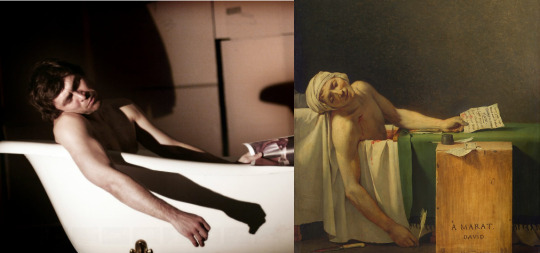
This is the very first scene of a controversial theatre adaptation of The Danton Case. Instead on portraying Robespierre as a firm leader, who only in the very end collapsed temporarily under the huge responsibility he now had to bear, the director decided to portray him as someone physically weak, not in the sense Danton meant when he called him a weakling, but in the sense of somebody who already bears so much responsibility, pain, physical ailments, doubts and whatnot. Just: everything, everythin a human could possible deal with, he deals with, and has to do so in a way that doesn't make people suspiscious about his "shortcomings". There is a interesting parallel between him and Saint-Just, whose upright and unbreakeable character is symbolised by a neck braces, something which people wear after a spine endangering accidents - and incidentally, wasn't it Saint-Just who accused Robespierre of "breaking his spine"? But not in this adaptation, oh no - here their very last scene is cut extremely short and they recite the last few sentences along with some Thermidor lines as two floating heads, a vision into the future which awaits them.
Enough about Saint-Just, though, let's focus on Robespierre and Marat. I must admit I know next to nothing about him, only what some passage here and there in this or that historical study might tell me, but I know, as does everybody, that he was known as L'ami du Peuple, which is why of the reasons, I think, why the director took this image and transposed it onto Robespierre: to make him even more likeable, to show for the umpteenth time that it is Robespierre whom we should cheer on and whom we should feel sorry for. This might also be a parallel between their both's tarnished health, their premature deaths and - last but not least - the role of an icon of the Rvolution both of them play in nowadays' audience's minds. You don't have to study history to knowwho Robespierre was, you don't have to study art to know this painting. Even if you don't agree with some more in-depth explanation of linking this person to this painting, it is a good opening image. It captures our attention in a good way.
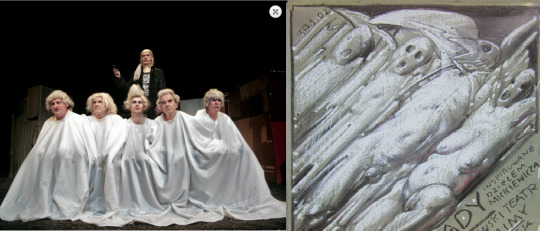
I had mention Saint-Just and there he is, in the background of the picture, symbolically assisting Danton and his clique in their last moments. Instead of shwoign them in torn shirts, the director went into another direction altogether and enshrouded them in white sheets from heads to toes, making them all look like very stereotypical ghosts, whom they will all become in just a couple of moments.
In Polish culture, the first thing that comes to mind when talking about ghosts is Dziady, an old slavic tradition that is now replaced with the Catholic All Souls Eve. Dziady is no longer, apart from perhaps some small minorities who still practice old pagan faiths, but as a ritual, they are immortalised in a play by Adam Mickiewicz, undoubtedly the greatest Polish poet ever. Everybody know this play, some scens - by heart, and they were and are being staged pretty much constantly from one point on. Needless to say, they inspire a lot of art, and I decided to show this very fmous poster by the most famous Polish poster designer, Franciszek Starowieyski…
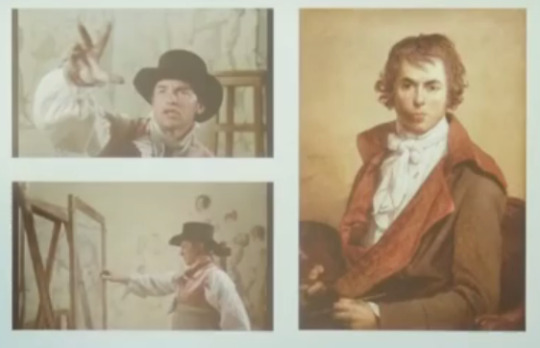
…who is important in this case, because he played David in Wajda's movie.
Not many people know - because his other carreer overshadowed by a lot his first one - that Wajda was a painter. Who actually hated his art, some of his pieces are in the national museum of contemporary art in Łódź alongside stars such as Władysław Strzemiński (the hero of Wajda's very last movie), which is a fact he absolutely detested. I dont know, nor do I care, why was that, because what matters is his previous education as an artist at the very least helped him not only to envision the visuals of the movie, but also acquainted him with great works of art. On which he could model this or that setup. I think it's a nice little detail he catsed Starowieyski as David, a real painter acting as another real painter, it adds a layer of reality onto the movie, and presumably makes for a more natural acting in the few scenes he was in his studio (I also think they look alike).
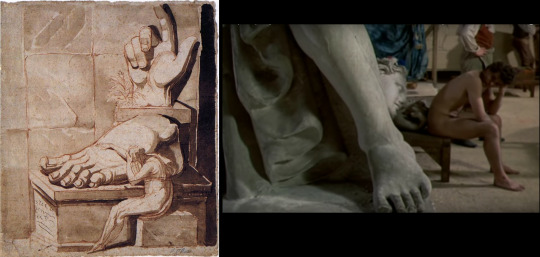
Speaking of David's studio, I once stumbled upon a lecture which drew parallels between some scenes in the movie and some paitings, which was mostly focused on character and costume design, and truth be told didn't contribute much to the overall watching experience of Danton. However, I must admit the lecturer had a very good eye in this one particular case, in which he pointed out that this quick shot in David's studio pretty obviously invokes the Fussli's The Artist's Despair Before The Grandeur Of Ancient Ruins. I don't think it's a coincidence (or at the very least, would be funny if it were) this shot is shown during the scene where Robespierre starts to grasp at desperate measures to save the country/save his own face in the trial. It is an artist's despair, only artist of a different kind. And it is a despair when being faced with a (possible) ruin of something great, even if its greatness is not yet formed, as opposed to the greatness passed.
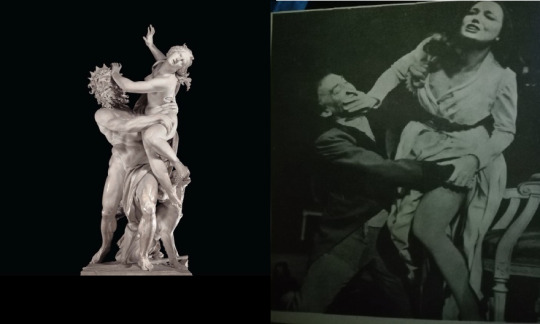
The very last example I was able to think of was this photo I found of The Danton Case from 1975. It is one of those old, very classical (I presume) adaptations, which are mostly filled to the brim with riddiculosly attractive people and very often deliberately drew from other sources of artistry, like the one pictured above. No matter what the real relationship between Louise Danton and her husband was, in the play it is portrayed as something atrocious, and I cringe whenever directors try to make it something else without good reasons for doing so, so I am very glad in the past at least they stuck with classicaly depicted acts of violation against women, not because it is a violation, but because in the classical stories (like the myth of Persephone shown in the sculpture above) the woman will usually get her revenge. Just like Przybyszewska's Louison did.
Thank you for bearing with me until the end, and if you have any other examples of this come to your mind, I compel you to share them with me!
List of pieces of art in the order of their appearance:
Jacques-Louis David, The Death of Marat
Franciszek Starowieyski, Dziady
Jacques-Louis David, Self-portrait
Heinrich Fussli, The Artist's Despair Before The Grandeur Of Ancient Ruins
Gianlorenzo Bernini, The Rape Of Persephone
#Stanisława Przybyszewska#stanislawa przybyszewska#andrzej wajda#the danton case#sprawa dantona#thermidor#jan klata#jerzy krassowski#jacques louis david#heinrich fussli#gianlorenzo bernini#art#ekphrasis#franciszek starowieyski#painting#sculpture#ekfraza#rzeźba#sztuka#Ekphrasis is my current hobby so I had to pull this together
40 notes
·
View notes